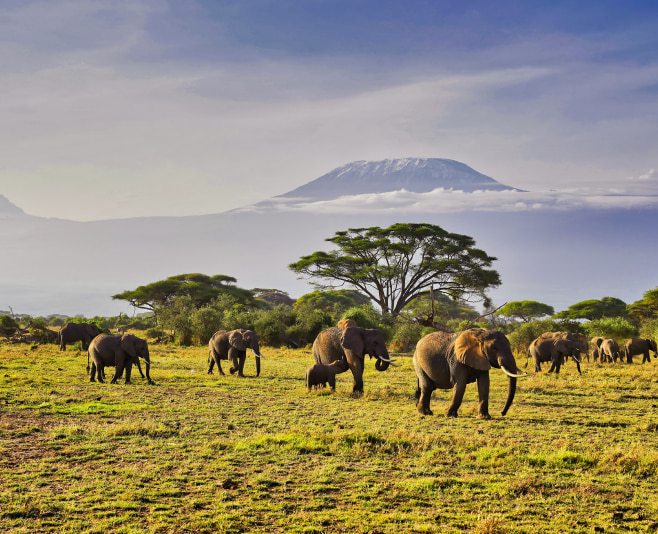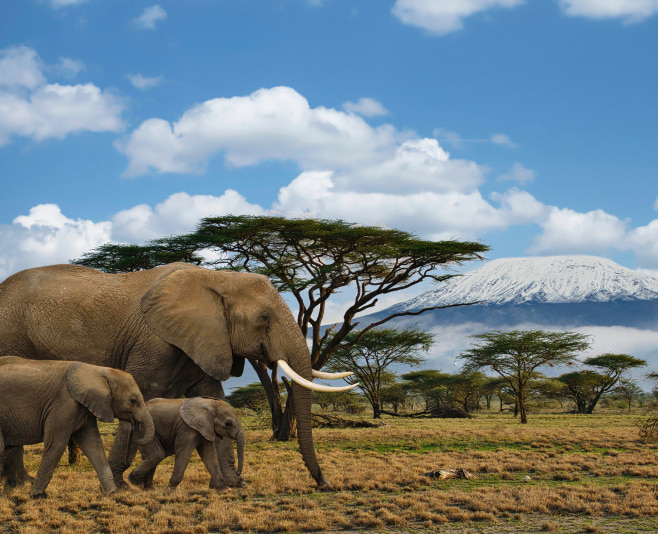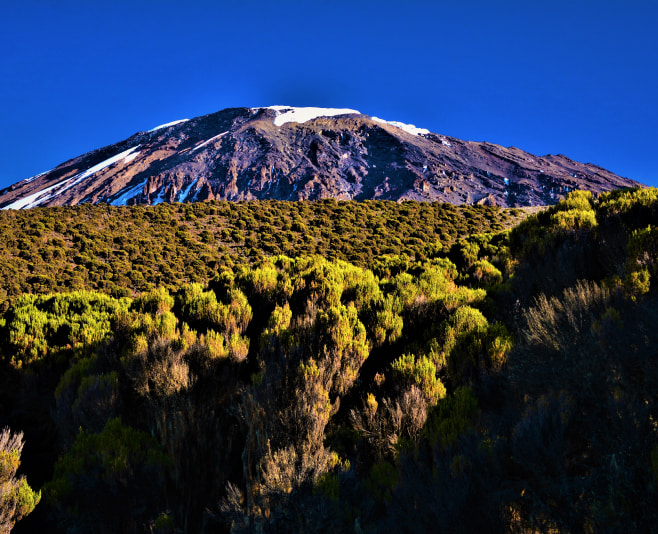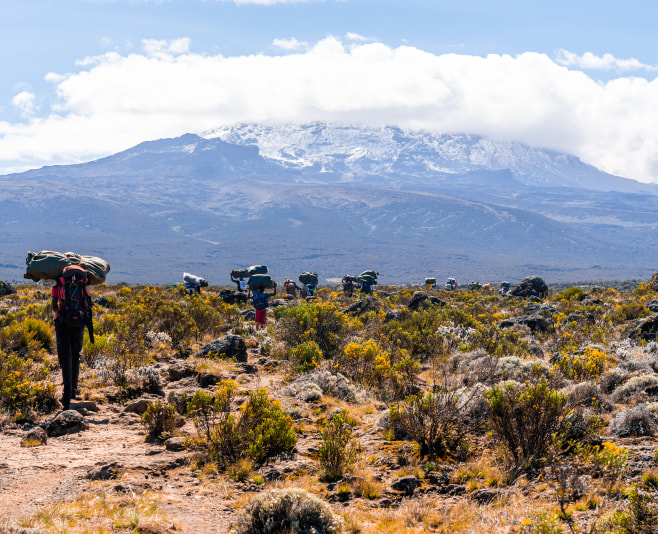Day Trip to Kilimanjaro National Park: A Gateway to Africa’s Roof
A day trip to Kilimanjaro National Park provides tourists with an amazing opportunity to see one of the most renowned spots in Africa without the demands of a full summit climb. It is situated in northern Tanzania, offering spectacular views of Mount Kilimanjaro towering above lush forests and rolling landscapes. The park attracts visitors with a diverse range of ecosystems, from rainforests teeming with monkeys and colorful birds to alpine moorlands adorned with unusual plants.
This travel guide will take you through the process of planning and enjoying a Kilimanjaro National Park day trip to help you enjoy the beautiful scenic pathways, the rich biodiversity, and the amazing views of the mountain’s glaciers. Whether you’re a nature lover, a professional photographer, or you just want to stand in the shadow of Africa’s highest peak, a day trip here offers lifelong memories and a closer connection to the wonders of Tanzania

Kilimanjaro National Park is a captivating destination that offers a unique blend of natural beauty, cultural immersion, and adventure
- Where is Kilimanjaro national park located in Tanzania?
- Kilimanjaro National Park Fees and opening hours
- How to travel to Kilimanjaro national park
- Beyond Marangu: Discovering All the Gates of Kilimanjaro National Park
- What to do in Kilimanjaro national park?
- Kilimanjaro National Park Day Trip Ready: Essential Tips for a Smooth Adventure
- Conclusion
Where is Kilimanjaro national park located in Tanzania?
Kilimanjaro National Park is located in northern Tanzania, near the border with Kenya. The park encompasses Mount Kilimanjaro, the tallest mountain in Africa boasting a height of 5,895 meters (19,341 feet) and is about 40 kilometers (25 miles) northeast of the city of Moshi. It is also approximately 80 kilometers (50 miles) away from Kilimanjaro International Airport (JRO), hence easily accessible by its travelers using air travel. The park is located in the Kilimanjaro Region and covers a wide range of ecological zones, which include dense montane forests, moorlands, alpine desert, and icy summit
Best Time to Visit Kilimanjaro National Park
The best time to visit Kilimanjaro National Park largely depends on what you wish to experience:
- Dry Seasons (Best for Hiking & Clear Views):
- January to mid-March: It has warm weather and comparatively clear skies. It’s the best season to trek without the crowds found towards the end of the year.
- June-October: Cool, dry with outstanding visibility. It is high trekking season particularly after the month of July; therefore more visitors are expected.
- Rainy Seasons (Less Ideal for Hiking):
- Mid-March- May (Long Rains): Mountains can be shrouded in cloud cover, and trails may become wet and slippery due to heavy rain. This is the time when trekking is difficult.
- November to mid-December (Short Rains): Light rains as compared to the long rainy season but still there can be rains.
During the dry seasons, it is best to have a clear view of the snow-capped peak of Kilimanjaro as the weather is warm at the lower altitude suitable for climbing or nature walks. Nonetheless, in the rainy seasons, the lower areas of the park are greener and more beautiful with fewer tourists.

The best time for climbing is during the dry season from late June to October.
Kilimanjaro National Park Fees and opening hours
Park Entrance Fees (Per Person, Per Day)
|
Visitor Category |
Fee (USD) |
Fee (TZS) |
| Non-East African Adult (>16 yrs) | $70 | – |
| Non-East African Child (5–15 yrs) | $20 | – |
| Resident/Expat Adult (>16 yrs) | $35 | – |
| Resident/Expat Child (5–15 yrs) | $10 | – |
| East African/Tanzanian Adult | – | TSh 10,000 |
| East African/Tanzanian Child (5–15 yrs) | – | TSh 2,000 |
| Children under 5 years | Free | Free |
Note: All fees are excluding 18% VAT. For example, a $70 entry fee becomes $82.60 with VAT.
Additional Fees
Camping Fees (Per Person, Per Night)
- Public Campsite:
- Non-East African: $50
- East African: TSh 10,000
Hut Accommodation (Marangu Route Only)
- Hut Fee: $60 per person, per night
Rescue Fee
- $20 per person, per trip (non-East African & residents)
- TSh 2,000 (East African citizens)
Mountain Biking Fee (Kilema Route)
- Non-East African: $50 per day
- East African: TSh 30,000 per day
Important Notes
- Charges are charged on a per person basis, per 24-hour period.
- Payment can be made through TANAPA’s official e-payment system using Visa or MasterCard.
- To know the current prices look up the most recent TANAPA publications before your trip or consult your tour operator.
- There can be higher numbers of visitors during the peak trekking seasons (June-October and January-March ), thus you should consider planning and book the permits beforehand.
Opening Hours
- Kilimanjaro National Park is open daily from 6:00 AM to 6:00 PM.
- The final entry into the park is typically around 4:00 PM to promote safety and ensure visitors can exit the park before closing time.
- It is only official accommodation (huts or campsites) in the park, or multi-day treks, which permit an overnight stay within the park.
How to travel to Kilimanjaro national park
A visit to the Kilimanjaro National Park is surprisingly convenient due to its setting in northern Tanzania, near large cities and transport bases . Whether you’re arriving internationally or exploring Tanzania’s famous safari circuit, there are several ways to reach this iconic park, home to Africa’s tallest mountain.
By Air
Kilimanjaro International Airport (JRO) is the gateway to Kilimanjaro National Park. It is located about 40–50 km (25–30 miles) from the park gates and accessible by international and local flights. Some of the major airlines that operate into JRO are Qatar Airways, KLM, Ethiopian Airlines, Turkish Airlines and Kenya Airways.
- By road, the main entrances to the park can be reached in about 45 minutes to 1 hour from Kilimanjaro International Airport, or from the town of Moshi, which serves as the main base for Kilimanjaro trips.
Alternatively, Arusha Airport (ARK) forms domestic flights, including those of Dar es Salaam, Zanzibar, and other cities of Tanzania. Nevertheless, the main tourist destination located in the country is JRO.
By Road
The most available way to reach Kilimanjaro National Park from close by cities is by road travel.
- A trip to park gates from Moshi Town (the closest town) takes approximately 30 – 45 minutes.
- From Arusha City, it’s roughly 80–90 km (50–56 miles) and about a 1.5 to 2-hour drive via the Moshi–Arusha highway.
The roads to the park are almost all paved and are in pretty good condition, though some of the internal park routes may be rough or muddy in the rainy season.

Kilimanjaro National Park can be reached by road from Arusha city
Public Transport
The buses and minibuses (daladalas) reach Arusha, and Moshi, however, they do not go into the national park. In case of taking public transport:
- Travel first to Moshi Town.
- From Moshi, arrange a private taxi, tour vehicle, or shuttle service to the park gates.
Public transport is affordable but not ideal, especially for travelers carrying a lot of equipment or those on tight schedules.
Using a Tour Operator
Most visitors prefer to book their Kilimanjaro adventure through a licensed tour operator. Benefits include:
- Organized transfers from the airport or your hotel.
- Professional guides and porters.
- Assistance with park permits and fees.
- Reliable vehicles suited for local road conditions.
Especially for those planning to climb Mount Kilimanjaro, traveling with a reputable operator ensures safety, logistics, and a smoother overall experience.
Beyond Marangu: Discovering All the Gates of Kilimanjaro National Park
Kilimanjaro National Park has a total of 8 gates — 7 entry points and 1 main exit gate (Mweka), each serving different trekking routes or day-trip visitors.
1. Marangu Gate
- The most famous and busiest gate.
- Entry point for the Marangu Route (Coca-Cola Route) — the only route with hut accommodation.
- About a 40–45 minute drive from Moshi.
- If you're planning a day trip, the Marangu Gate is the most accessible and ideal starting point, especially for short hikes in the rainforest zone
2. Machame Gate
- Starting point for the popular Machame Route (Whiskey Route), known for its diverse scenery.
- Located on the southern side of Kilimanjaro.
- Roughly 1–1.5 hours from Moshi by car.
3. Lemosho Gate
- Entry for the Lemosho Route, considered one of the most scenic and less crowded routes.
- More remote than other gates; usually requires a 4x4 vehicle.
- Some tours first check in at Londorossi Gate, then proceed to Lemosho.
4. Londorossi Gate
- Another major gate for the Lemosho Route and Shira Route.
- Check-in and permit processing often take place here before proceeding further.
- Approximately 2–3 hours from Moshi.
5. Rongai Gate
- Starting point for the Rongai Route, the only route beginning on Kilimanjaro’s northern side, near the Kenyan border.
- Quiet and less trafficked — perfect for those seeking solitude.
6. Umbwe Gate
- Entry for the Umbwe Route, the shortest but steepest and most challenging trail.
- Recommended only for experienced trekkers.
7. Mweka Gate
- Not an entry point for starting climbs but serves as the exit gate for many routes, including Machame, Lemosho, and Umbwe.
- Used for check-out procedures, returning permits, and transfers back to Moshi or Arusha.

Mount Kilimanjaro National Park can be accessed using one of 8 gates that act as entry and exit points
What to do in Kilimanjaro national park?
Kilimanjaro National Park is much more than just a mountain climb; it’s a tapestry of colorful landscapes, unique wildlife, and cultural experiences. It is a fairytale of colorful landscapes, unusual wildlife, and rich culture. Being a trekker or a nature enthusiast or a traveler who just wants to have a memorable day trip, the number of things to do in Kilimanjaro National Park is so exciting that every traveler will find something to enjoy. Here’s a look at the top eight activities that will make your visit unforgettable.
1. Climb to Uhuru Peak
The final quest of course is climbing Mount Kilimanjaro to the Uhuru peak, which is 5895 meters (19341 feet). While summiting Uhuru Peak requires a multi-day trek, a day trip to Kilimanjaro National Park offers scenic hikes in the lower rainforest zone and stunning views of the mountain. The different treks take between five to nine days depending on the route you wish to take to ensure that you are well acclimatized. This is undoubtedly one of the most iconic things to do in Kilimanjaro National Park.
All visitors undertaking treks within the national park must be accompanied by a licensed guide as per TANAPA regulations.
Note: Reaching Uhuru Peak requires a multi-day trek (typically 5–6 days); day trips only reach Mandara Hut on the lower slopes.

Uhuru Peak is the highest summit of Mount Kilimanjaro and the tallest point in Africa
2. Explore the Rainforest Zone
The lower slopes of Kilimanjaro offer enchanting rainforest treks. Within this green belt, one may find blue monkeys, colobus monkeys, gorgeous orchids and magnificent trees that have been covered by moss. Guided hikes open up views of the waterfalls, birds and the biodiversity that has made the foothills of Kilimanjaro special. It is an affordable means to enjoy the natural beauty of the mountain without all the strenuous high-altitude climbing
3. Visit the Shira Plateau
The plateau, the Shira, which is still the remnant of the volcano in ancient times, is approximately 3,500 meters and provides the magnificent views of the mountain and plains. Shira Plateau, while spectacular, is typically visited on multi-day treks via the Lemosho or Shira routes and is not suitable for a standard day trip. It is an unbelievably spectacular site to experience how stark the change between the forest and the moorland is with its spectacular views of the awesome Kibo Peak and its glaciers even as a day hike.
The Shira Plateau is the remnant of an ancient caldera, extending about 13 kilometers across to the west of the snow-covered Kibo summit.
4. Discover Maundi Crater
Located near the Marangu Route, Maundi Crater is a popular short hike. It has panoramic vistas on the plains of Kenya. It also gives one a very good feeling of elevation without enduring a long climb. The crater rim has fertile grass and is littered with endemic plant species thus becoming a beautiful place to go photography and birdwatching.
5. Go Bird Watching
Kilimanjaro National Park has more than 200 species of birds found on its territory, such as bright turacos and sunbirds of the rainforest, alpine chats, and augur buzzards at elevated altitudes. The mountains provide a variety of altitude, therefore, making the park a haven to whatever birder. Don’t forget to bring your binoculars to have a glimpse of the rare species in the woods or just on the backdrop of the dramatic mountains.
6. Enjoy Day Hikes
Not every visitor has time for a full summit trek. Day hikes in Kilimanjaro National Park are perfect for travelers seeking a taste of the mountain without the multi-day commitment. Routes like the Mandara Hut hike on the Marangu Route let you walk through diverse terrain, spot wildlife, and enjoy fantastic views—all in a single day.

Experience the magic of Mount Kilimanjaro on our one-day hike , perfect for travelers with limited time
7. Visit Waterfalls
There are also beautiful waterfalls hidden on the sides of Kilimanjaro such as the Kinukamori and Materuni Falls. Although technically outside the official boundaries of Kilimanjaro National Park, Materuni and Kinukamori Falls are popular day-trip destinations in the surrounding foothills. These waterfalls provide cool escapades in the midst of green forest and would be ideal for swimming and photography.
8. Learn About Chagga Culture
Tour packages are becoming popular that include national park visits and the cultural visit to the Chagga villages near Kilimanjaro. You can enter a traditional house, taste banana beer, take part in a coffee farm tour and listen to the history of the Mount and how it is very important to Chagga people. It’s an excellent way to tie the park's natural highlights to Tanzania’s culturally rich past.
Kilimanjaro National Park Day Trip Ready: Essential Tips for a Smooth Adventure
Kilimanjaro National Park with the highest point in Africa provides various activities including multi-day trekking of the peak of Kilimanjaro to informative daytime explorations. Whether you’re aiming at the top or a casual walk on lower slopes, it is always important to plan a successful visit.

Here are some of tips for planning and traveling in Kilimanjaro National Park
Prepare for Altitude
Even low treks in the park include large elevations.Spend at least a couple of days acclimatizing if visiting altitudes above 3,000 meters. Altitude sickness can get you, so mind your body, go at an adequate pace and drink a lot of water.
Bring Cash for Tips
Tipping guides, porters, and cooks is customary and a vital part of the local tourism economy. Budget for this in advance, as ATMs can be unreliable in remote areas.
Bring Appropriate Gear
Pack layered clothing for temperature variations—from humid rainforests to chilly alpine zones. Essentials include:
- Sturdy, comfortable hiking boots
- Waterproof jacket
- Warm layers for cold nights
- Hat and gloves
- Sunscreen and sunglasses
- Reusable water bottle
Consider a Guide or Tour Operator
The best advice is to hire an official guide or use a tour operator, and it is quite recommended. Guides will offer expertise, take care of logistics, and provide safety, in particular, in case of summiting. In Kilimanjaro, no person is allowed to trek alone beyond a specific altitude.
Arrange Your Park Permits
All visitors must pay park fees, which vary depending on activities and routes. Fees are charged per person, per day, and are subject to 18% VAT. It is advisable to book in advance the permits and payments through your tour company.
Essential Travel Documents
- Valid Passport: Passport has to be valid at least six months after the day you plan to leave and have sufficient blank pages.
- Tanzania Visa: A visa is necessary by most nationalities. Apply (online) very early to get an e-Visa or find out whether you are eligible to get a visa on arrival.
- Yellow Fever Certificate: Required if you are arriving from, or transiting through, countries considered at risk for Yellow fever.
- Travel Insurance: Buy comprehensive travel insurance including high-altitude trekking (in case of summiting) and medical flight. This is essential and non-negotiable
- Flight Tickets and Itinerary: Carry both soft and hard copies of your flight tickets and itinerary to the safari/trek.
Respect the Environment and Local Culture
- Leave No Trace: Carry out all your trash, use designated toilets, and stay on marked trails.
- Support Porters: Treat your porters and guides with respect. Acknowledge their hard work.
- Cultural Sensitivity: Be mindful of local customs if you interact with communities in nearby towns.
Conclusion
In conclusion, a day trip to Kilimanjaro National Park offers a truly remarkable and accessible way to experience Africa's highest mountain. It stands as a perfect alternative for those with limited time or who prefer a less strenuous adventure than a multi-day summit bid.
From trekking through enchanting montane rainforests and spotting unique wildlife like black-and-white colobus monkeys, to enjoying crisp mountain air and breathtaking views of Kibo Peak, this single-day excursion provides a profound connection with Kilimanjaro’s majestic ecosystem.
Related Articles
- Top 15 Churches To Visit in Tanzania That Blend Beauty and History
- The Great Migration Tanzania Safari: A Complete Guide to the World’s Greatest Wildlife Show
- Ultimate Mtwara Tanzania Travel Guide: Best Things to Do and How to Plan Your Trip
- Tanzania Family Holiday Guide: Creating Memories That Last a Lifetime
- Tanzania Tourist e-Visa for First-Time Travelers: A Complete Online Application Guide











